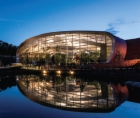Center Parcs joins forces with Jaga at Woburn Forest

To help meet the very varied heating requirements of Center Parc’s £250 million village in Woburn Forest in Bedfordshire, Jaga was heavily involved in the specification process. To provide the best solutions in terms of design and performance, a combination of Strada radiators and Mini Canal trench heaters was recommended. In addition, the decorative Jaga Twine was installed in various public reception areas and the Sentinel LST in numerous stairwells, bathrooms and medical consultation facilities.
The village has a biomass district-heating system.
Strada wall-mounted radiators have a front panel that is cool to the touch and incorporates Jaga’s Low-H2O technology to reduce water content and increase energy efficiency.
Mini Canal units also have Low-H2O heat exchangers and are discreetly installed into floor trenches in restaurant areas.
Jaga Twine radiators provide an attractive accompaniment to the interior design values of the project. They are available in 32 standard colours and eight special colours — with the option of a glossy or matte finish.
Sentinel LST radiators were installed in the internal medical facilities and first-aid centre.
M&E contractor was Derry Building Services.







